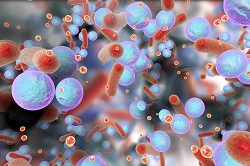Low-cost, flexible substrates for nanoplasmonic sensing
Thanks to their unprecedented ability to concentrate light at the nanometre scale, plasmonic nanostructures have played a significant role in the field of nanotechnology, particularly as to their use in various sensing applications. ‘The adsorption of plasmonic nanoparticles onto substrates in a controlled manner is a crucial process for the fabrication of nanoplasmonic devices where the nanoparticles amplify the electromagnetic fields for enhanced device performance,’ says Luis Liz-Marzán, project coordinator of the EU-funded PLASMAQUO project. The PLASMAQUO project aimed to develop nanostructured materials based on plasmonic gold nanoparticles as substrates for ultra-sensitive detection of the communication processes between living cells. ‘In particular, we focused on a bacterial cell-to-cell communication phenomenon, termed quorum sensing, which relies on the production, release and sensing of small signalling molecules that allow bacteria to monitor their local environment and population density,’ explains Liz-Marzán. Quorum sensing is known to regulate a wide range of microbial physiological processes, including virulence and the formation of bacterial biofilms, which are the most successful form of colonisation among microbes. ‘As quorum sensing and biofilms are intimately linked with the pathogenesis of various persistent infectious diseases, such as pneumonia in cystic fibrosis, there is a need for the development of new strategies for the non-invasive analysis of quorum sensing in living bacterial populations,’ says Liz-Marzán. ‘The ability to visualise this form of chemical communication within microbial populations will extend our understanding of its functions and may lead to new anti-bacterial therapeutic strategies with relevant biomedical applications.’ Beyond state-of-the-art Project researchers used surface enhanced Raman scattering (SERS) spectroscopy, an analytical technique that relies on the generation of high electric fields at the surface of metallic nanoparticles through illumination under surface plasmon resonance conditions. However, owing to the inherent limitations of SERS, reliable sensing in complex biological media is still challenging due to the background noise from interfering species and the non-specific adsorption of biomolecules that could hinder the interaction of target molecules with the SERS-active surface. To overcome this challenge, PLASMAQUO devised plasmonic nanostructured substrates as platforms for growing bacterial cultures and in-situ, label-free detection of the secreted signalling molecules toward the plasmonic sensor. In order to avoid contamination of the optical sensor with other biomolecules present in the culture medium, the team fabricated cell-compatible hybrid materials comprised of a plasmonic component within a porous matrix. This functions as a molecular sieve to restrict the diffusion toward the metallic nanoparticles. ‘PLASMAQUO went beyond the state-of-the-art in the fields of colloidal nanoparticle synthesis, colloidal phase behaviour studies and understanding of SERS mechanisms for designing new and highly efficient plasmonic nanoparticles,’ says Liz-Marzán. Paving the way This work allowed researchers to demonstrate the performance of various purpose-designed plasmonic materials for detection and imaging of quorum sensing in biofilms of the opportunistic human pathogen Pseudomonas Aeruginosa. According to Liz-Marzán, the project paved the way for the application of plasmonic sensors in various fields. For example, they could be incorporated in implants, catheters or implantable medical devices to monitor a possible infection in a non-invasive manner. ‘Given the resistance of bacterial biofilms to chemical cleaning agents, these have a great impact on different industries,’ adds Liz-Marzán. ‘The application of plasmonic sensors for in-situ detection by portable Raman devices could allow their early detection and favour their eradication.







